If you’re looking for a tattoo design that’s rich in history and symbolism, then look no further than Egyptian tattoos. These designs have been popular since ancient times, and they continue to be sought after today. In this article with Impeccable Nest, we’ll explore the captivating world of Egyptian tattoo designs and their meanings.
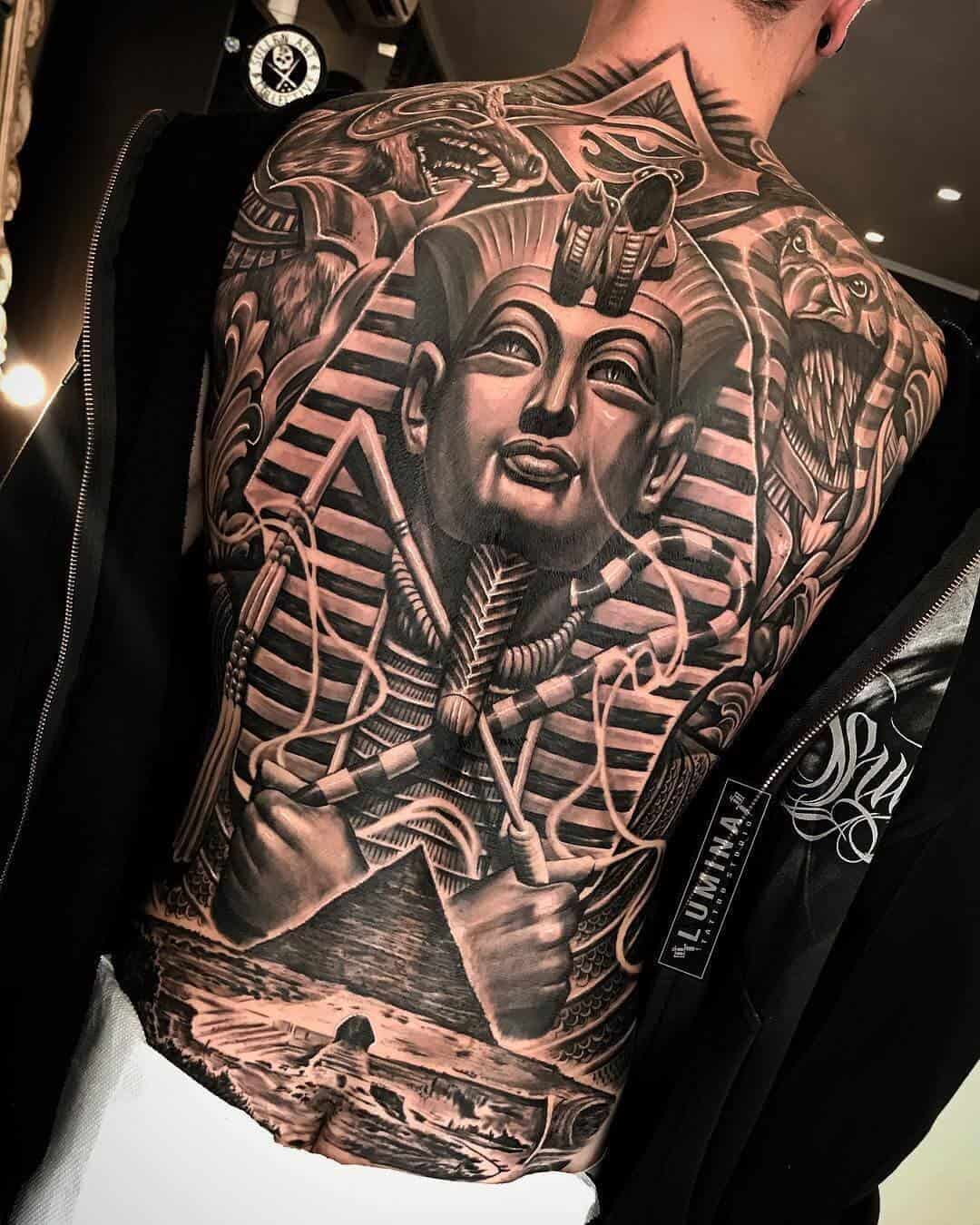
Egyptian Tattoo Meaning: Unveiling the Symbolic Power
Egyptian tattoos draw from the rich history, mythology, and symbolism of ancient Egypt. These tattoos often carry deep meanings related to spirituality, culture, and personal beliefs. Here are some common Egyptian tattoo symbols and their meanings:
Ankh Tattoo
The ankh is a significant symbol in Egyptian culture and mythology, dating back thousands of years. It is often depicted as a cross-like shape with a loop at the top, resembling a key. The ankh has been associated with various meanings throughout history, but one of its most common interpretations is that it represents life and immortality.
In ancient Egypt, the ankh was closely linked with the gods and goddesses, who were believed to hold the keys to eternal life and the afterlife. It was often depicted being held by deities such as Isis, Osiris, and Horus, who were associated with resurrection and rebirth. The ankh was also used as a powerful talisman, believed to offer protection and good fortune to those who wore it.
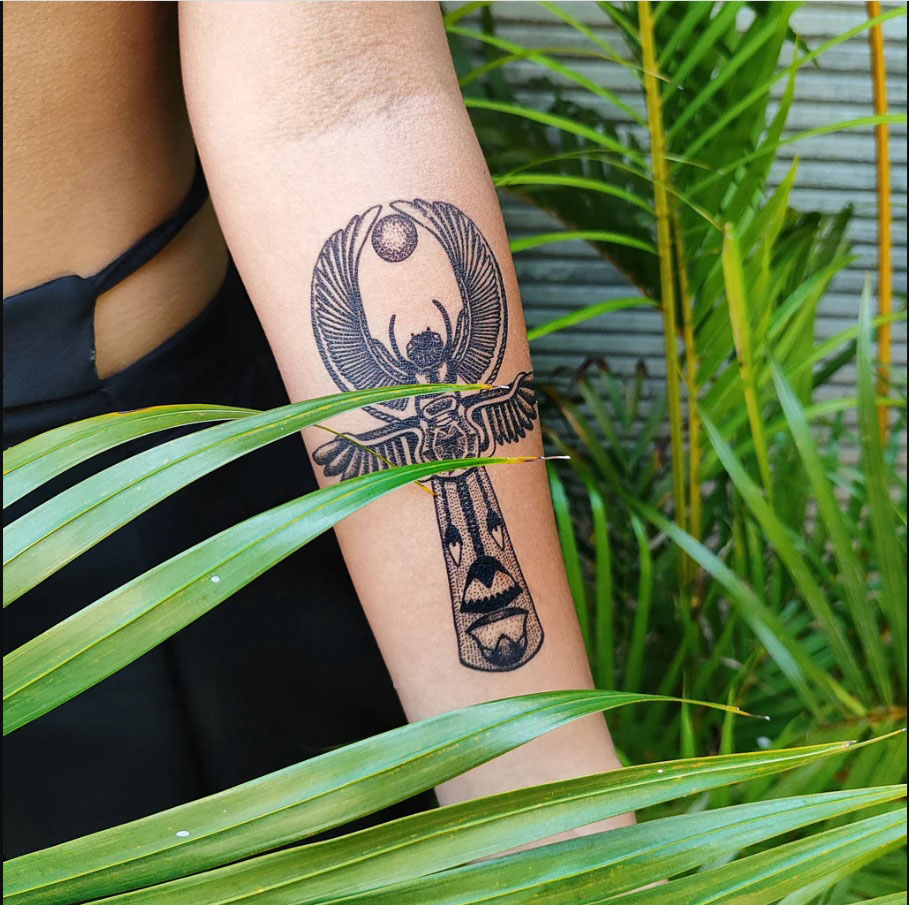
Aside from its association with life and immortality, the ankh has also been interpreted as a symbol of balance and harmony between opposing forces. The loop at the top of the cross represents the feminine energy, while the vertical line represents the masculine energy. Together, they create a perfect balance, representing the unity of opposites.
In contemporary times, the ankh has become a popular tattoo design, often chosen for its aesthetic appeal and spiritual significance. People choose to get an ankh tattooed on their body for various reasons, including as a symbol of their belief in the afterlife, as a reminder of the importance of balance and harmony in their lives, or simply because they find the design beautiful.
Eye of Horus Tattoo
The Egyptian tattoo featuring the Eye of Horus is a popular design that holds deep meaning within Egyptian mythology. This ancient symbol, also known as the “Wedjat” eye, represents the protective power and healing abilities of the falcon-headed god Horus.
According to legend, Horus was the son of Osiris, the god of the afterlife, and Isis, the goddess of fertility and motherhood. Horus was often depicted with the head of a falcon, which symbolized his keen eyesight and ability to soar above earthly matters.
The Eye of Horus was said to have been lost during a battle between Horus and the god Set, who had killed Horus’s father Osiris. The eye was eventually restored by the goddess Hathor, and it became a powerful symbol of protection and healing.
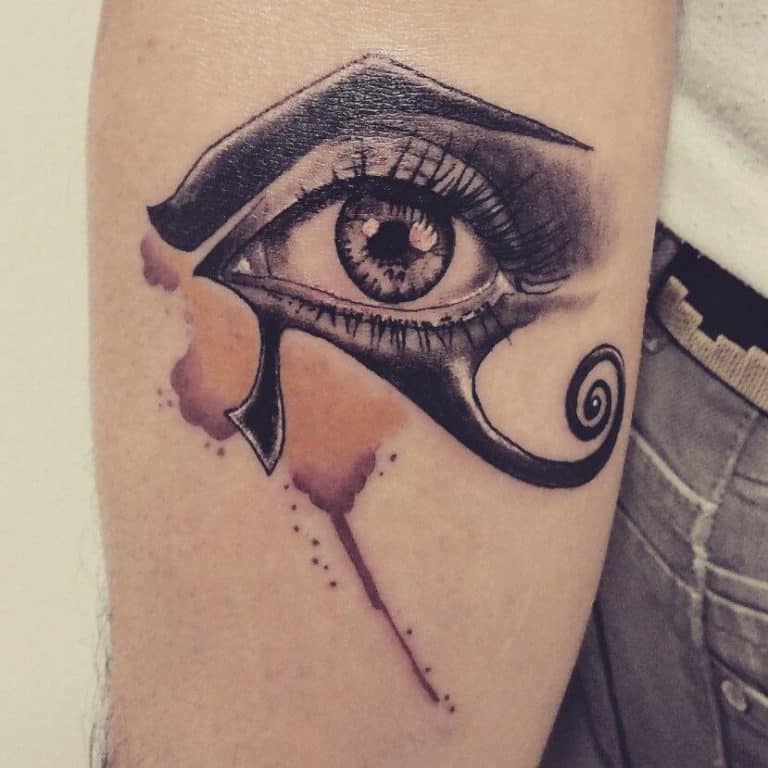
In ancient Egypt, the Eye of Horus was often used as a talisman or amulet to offer protection against evil forces. It was also believed to have healing properties and was used in medical treatments to cure ailments such as blindness and infertility.
Today, the Eye of Horus remains a popular tattoo design that is often chosen for its powerful symbolism. Those who choose to get this tattoo may be seeking protection or healing in their own lives, or they may simply appreciate the rich history and mythology behind this ancient symbol. Regardless of the reason, the Eye of Horus tattoo is a meaningful and powerful choice that represents the enduring legacy of ancient Egyptian culture.
Scarab Beetle Tattoo
Egyptian tattooing has a long and rich history, dating back to ancient times. One of the most popular and meaningful symbols in Egyptian tattoo art is the scarab beetle. The scarab beetle was an important symbol in ancient Egyptian culture, representing transformation, renewal, and protection.
In ancient Egypt, the scarab beetle was closely associated with the sun god Ra. It was believed that the beetle rolled the sun across the sky each day, just as it rolled its dung into a ball. For this reason, the scarab beetle became a powerful symbol of rebirth, renewal, and regeneration. It was also believed to bring good luck and fortune to those who wore it, and to ward off negative energies and evil spirits.
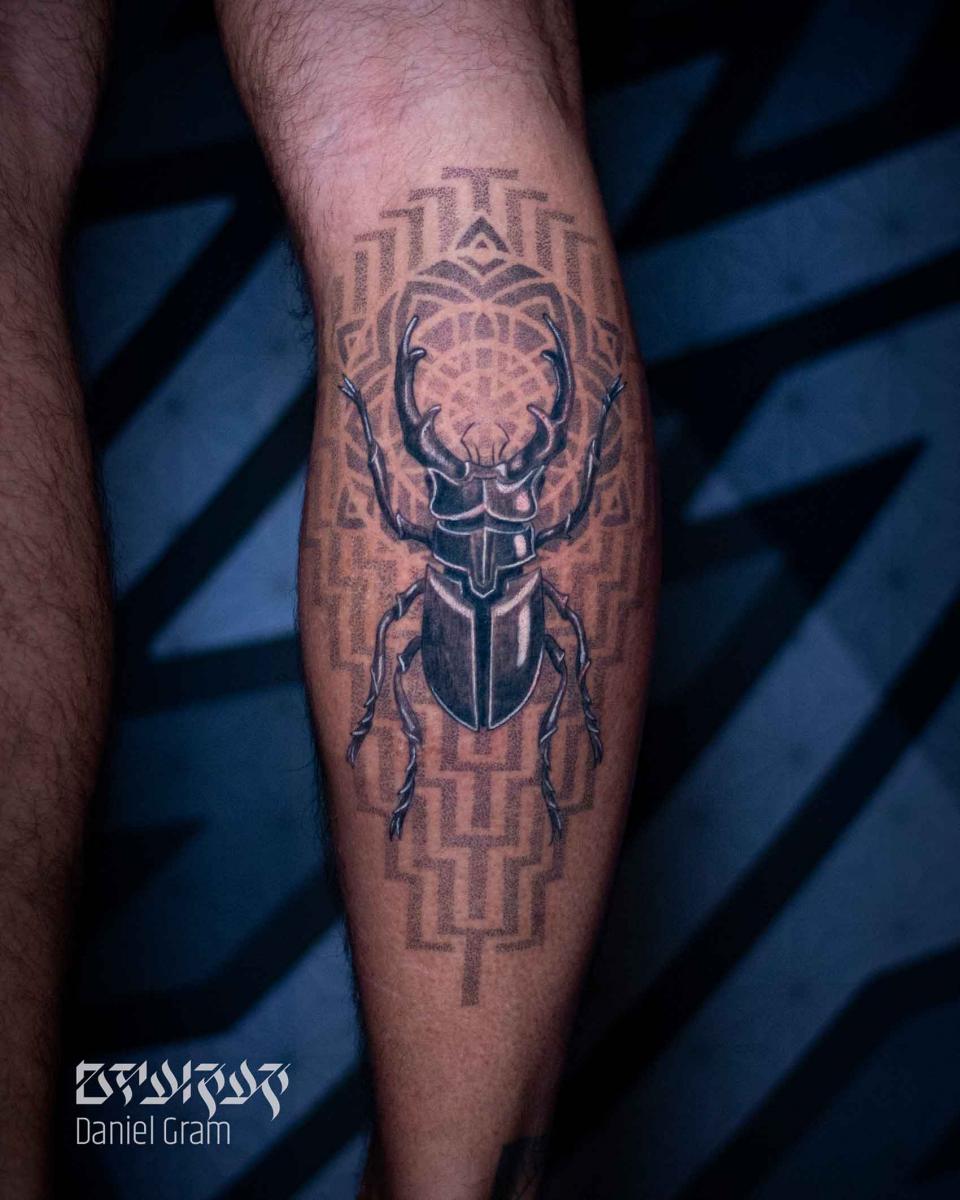
The scarab beetle was often depicted in ancient Egyptian art and was used in amulets, jewelry, and other objects. Its symbolic meaning was so important that some pharaohs were even buried with scarab beetles in their tombs, to ensure their safe passage to the afterlife.
In Egyptian tattoo art, the scarab beetle is often depicted in its traditional form, with its wings spread wide and its legs curled underneath. It may also be shown rolling its dung ball or holding a sun disc. The beetle may be depicted alone, or it may be part of a larger design, such as a scene from ancient Egyptian mythology.
Sphinx Tattoo
In Egyptian culture, the sphinx holds significant meaning and symbolism. The creature is believed to have originated from ancient Egyptian mythology, where it was seen as a guardian of sacred places and an enigmatic figure associated with the sun god Ra.
The sphinx’s appearance is striking, with the body of a lion representing strength, power, and courage, while the human head symbolizes intelligence and wisdom. The combination of these two features conveys a message of balance and harmony between animalistic and human traits, suggesting that strength and wisdom must work together to achieve success.
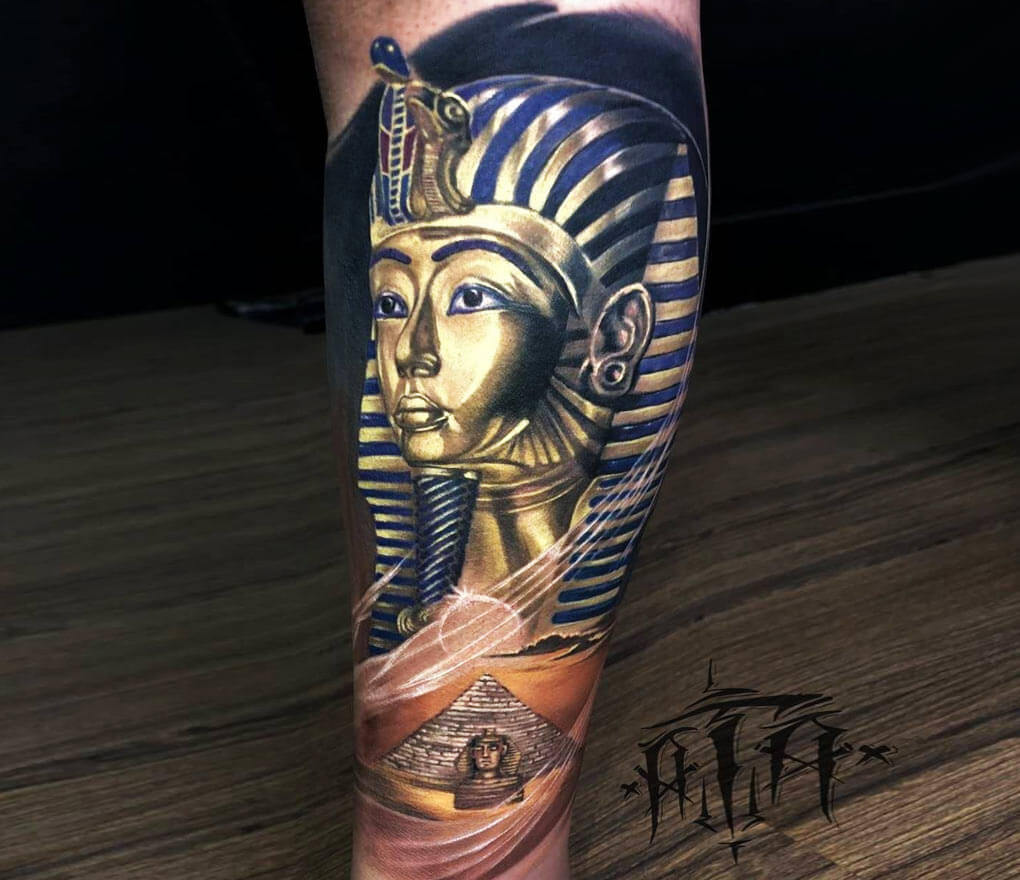
Furthermore, the sphinx is known for its riddles and enigmatic nature, which adds to its mystery and allure. In Egyptian mythology, the sphinx would often pose riddles to travelers passing by, challenging them to think creatively and test their knowledge. This aspect of the sphinx has made it a popular choice for tattoos among those who value intelligence and problem-solving abilities.
Moreover, the sphinx is also closely associated with the Egyptian pharaohs, who saw themselves as the protectors and guardians of their people. The sphinx’s role as a guardian of sacred places further reinforces its significance as a symbol of protection and guidance.
In modern-day tattoo culture, the sphinx is a popular design choice for those seeking to convey a sense of mystery, wisdom, and guardianship. It is often depicted in various styles, ranging from realistic to abstract, and can be incorporated into larger tattoo designs or stand alone as a focal point.
Bastet Tattoo
Bastet is a goddess of ancient Egyptian mythology who was often depicted with the head of a cat and was associated with various aspects of feminine power, such as protection, fertility, and motherhood. Her mythology and iconography have made her a popular subject for tattoos among those who identify with or appreciate these qualities.
In Egyptian mythology, Bastet was considered to be the protector of households, especially those with children, and was associated with fertility and childbirth. She was also believed to embody grace and elegance, as well as the nurturing qualities associated with motherhood. As a result, a tattoo of Bastet can serve as a symbol of these qualities, representing the wearer’s connection to feminine power, strength, and nurturing capabilities.
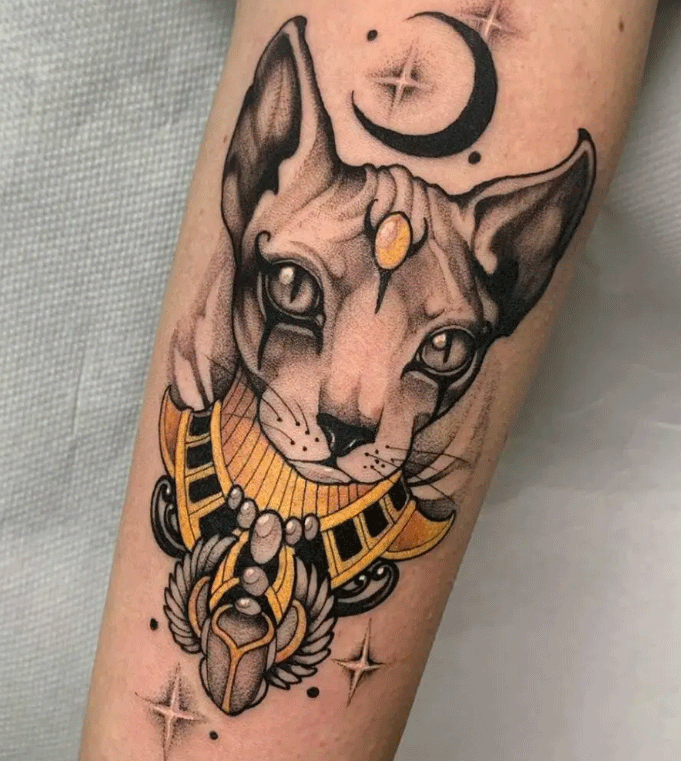
The image of Bastet is often depicted in Egyptian art with a tall headdress, elaborate jewelry, and sometimes holding a sistrum, a musical instrument associated with ritual worship. She is frequently shown sitting or standing, with her posture conveying her regal bearing and commanding presence.
For those who choose to get a tattoo of Bastet, there are a variety of design options available. Some may opt for a simple outline of her head or face, while others may choose a more detailed depiction that includes additional elements such as the headdress or sistrum. The tattoo may also include other symbols or images associated with Bastet, such as the ankh (a symbol of life) or lotus flower (representing rebirth and renewal).
Horus Falcon Tattoo
Egyptian culture is rich in symbolism and mythology, with numerous gods and goddesses representing different aspects of life. One of the most iconic symbols in Egyptian mythology is the falcon-headed god Horus, who was worshipped as a protector, divine guide, and leader.
Horus was believed to be the son of Osiris and Isis, two of the most powerful deities in the Egyptian pantheon. He was often depicted as a falcon or a man with a falcon’s head, which symbolized his keen eyesight and ability to soar to great heights. In Egyptian mythology, Horus was known for his bravery and courage in battle, as well as his wisdom and guidance.
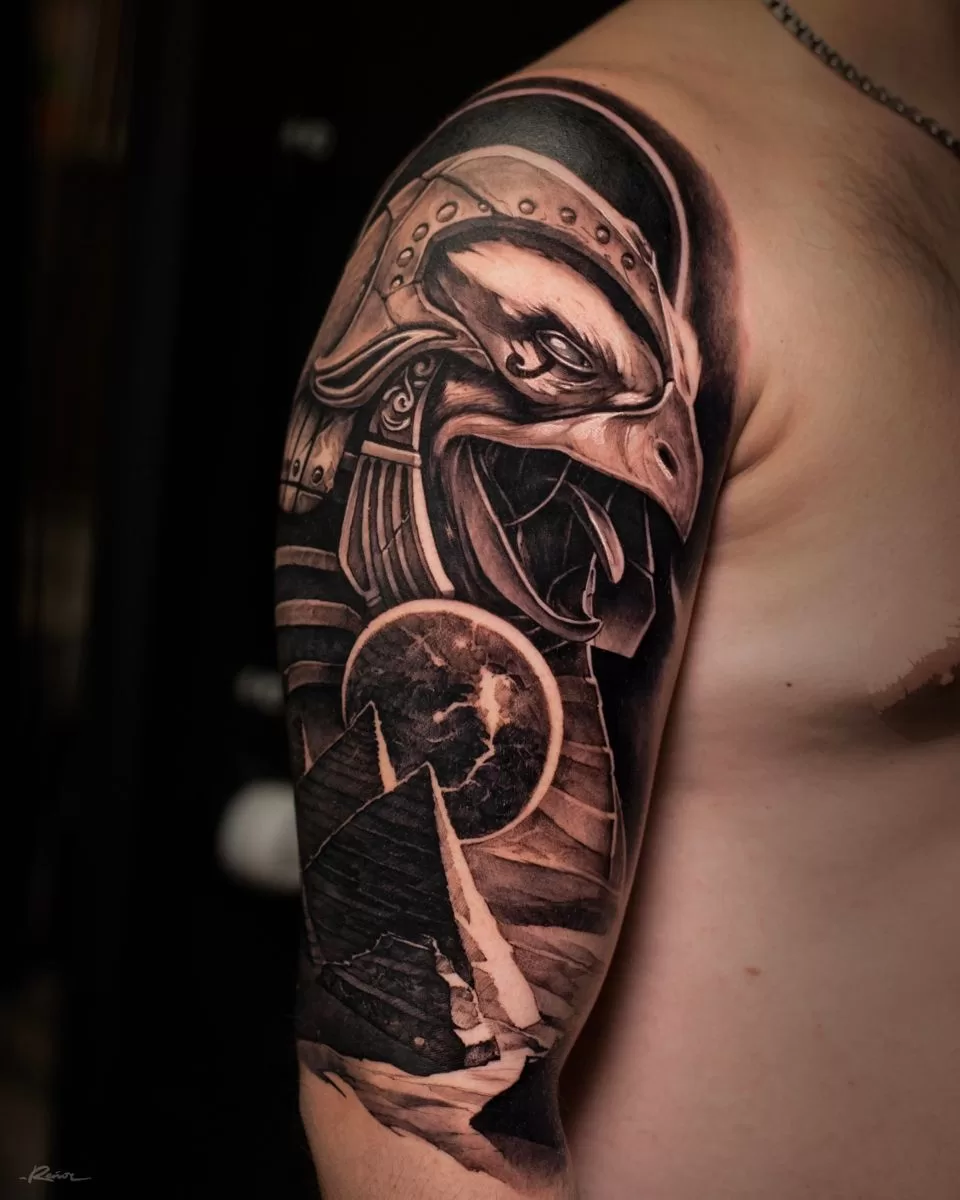
For this reason, many people choose to get tattoos of Horus as a way to honor his legacy and tap into his power. A tattoo of Horus can signify protection, vision, and leadership, as well as divine guidance and strength. It can also represent the wearer’s connection to Egyptian culture and mythology, and their admiration for the values and qualities that Horus embodied.
In addition, Horus was often associated with the sun and the sky, and was believed to be the god of light and goodness. As such, a tattoo of Horus can also symbolize enlightenment, illumination, and spiritual awakening. It can be a reminder to strive for higher ideals and to seek guidance from a higher power.
Nefertiti Tattoo
Egyptian culture is rich in symbolism and iconography, and tattoos inspired by this ancient civilization are becoming increasingly popular. One of the most recognizable figures from Egyptian history is Queen Nefertiti, who reigned alongside her husband Pharaoh Akhenaten in the 14th century BCE.
Nefertiti is often depicted with a tall, elegant headdress and a serene expression that seems to radiate beauty and grace. Her features have become iconic in popular culture, and her image has been reproduced in countless artworks, jewelry designs, and even tattoos.
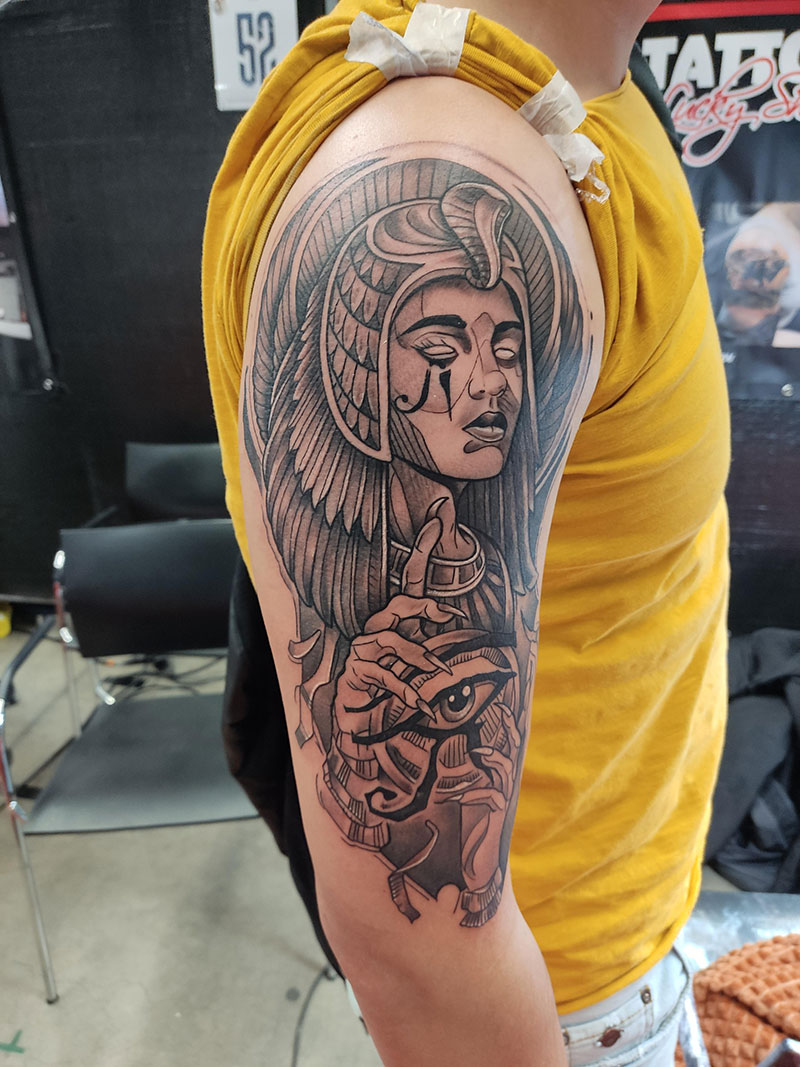
For those who choose to get a tattoo of Nefertiti, there are many possible meanings and interpretations. At its core, a Nefertiti tattoo can symbolize femininity, beauty, and strength. This is because Nefertiti was not only renowned for her physical beauty, but also for her intelligence, political savvy, and leadership abilities. As a queen, she wielded considerable power and influence, and was known for her progressive ideas and religious reforms.
Additionally, Nefertiti’s image can be seen as a representation of ancient Egyptian culture and its enduring legacy. By getting a tattoo of this powerful queen, one can pay homage to the rich history and artistic traditions of Egypt, and connect with the spiritual and cultural significance of this fascinating civilization.
Pyramids Tattoo
Egyptian tattoo designs have become increasingly popular over the years, and one of the most recognizable symbols associated with Egypt is the pyramid. Pyramids were built by ancient Egyptians as tombs for their pharaohs and symbolized power and wealth. However, in modern times, pyramids have taken on a deeper meaning and can represent ancient wisdom, spirituality, and the pursuit of higher knowledge.
The pyramid’s shape has a lot of significance in Egyptian mythology and beliefs. The triangular shape represents the trinity of creation, preservation, and destruction which are the three stages of life in Egyptian mythology. It also represents the connection between heaven and earth as the pyramid points towards the sky. The pyramid was believed to be a gateway between the physical world and the spiritual realm, a belief that still resonates with many people today.
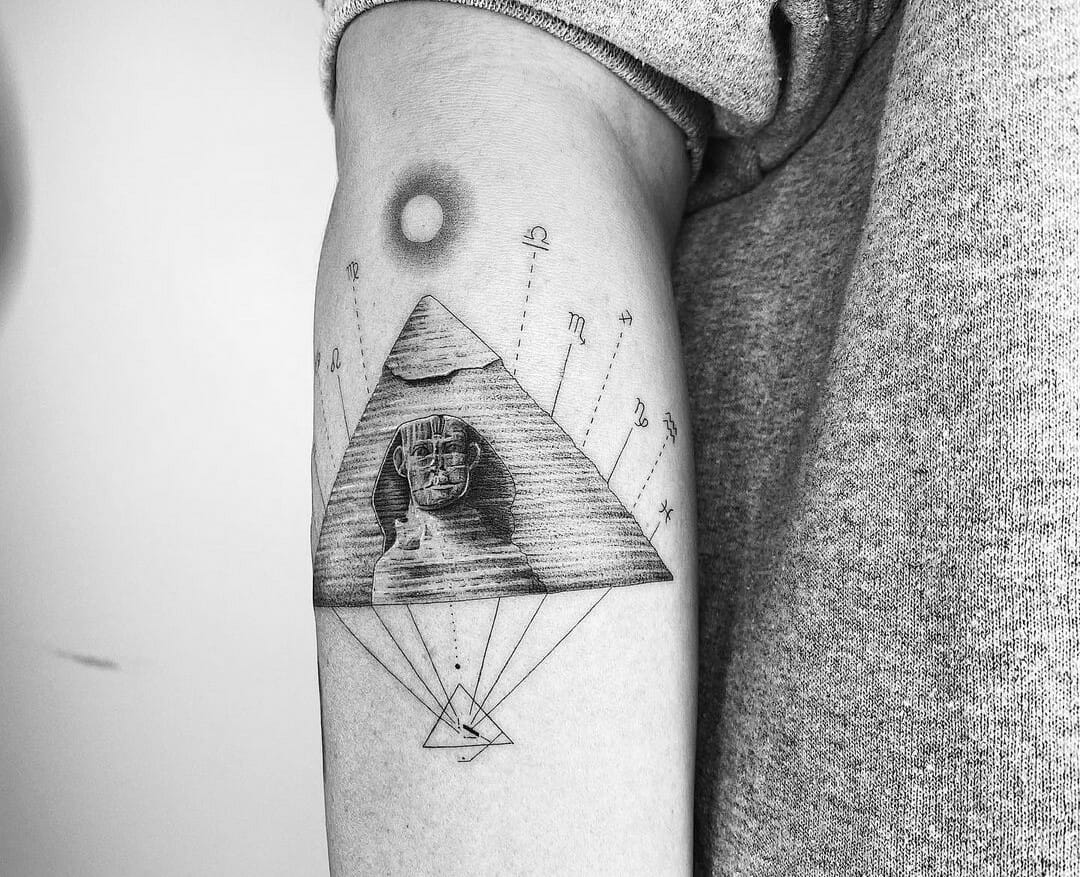
Beyond its spiritual significance, the pyramid is also a symbol of ingenuity and architectural prowess. Building such monumental structures without the use of modern machinery or technology is a testament to the intelligence and skill of the ancient Egyptians. Thus, having a pyramid tattoo can be a reminder of the remarkable human achievement and the potential we all have within us.
When it comes to Egyptian tattoos, the pyramid design is often combined with other elements like the Eye of Ra, Ankh or Scarab beetle to create a more personalized and meaningful tattoo. The Eye of Ra is an ancient Egyptian symbol associated with protection, healing, and restoration, while the Ankh represents eternal life and vitality. The Scarab beetle, on the other hand, is connected to rebirth and transformation, making it a popular choice for those seeking a fresh start.
Lotus Flower Tattoo
Egyptian tattoo designs often incorporate powerful symbols and motifs from ancient Egyptian culture, which have deep spiritual significance. One such symbol is the lotus flower, which has a rich history and carries profound meaning. In Egypt, the lotus flower was associated with the sun and creation, as well as rebirth and purification.
The lotus flower’s importance in Egyptian mythology can be traced back to the creation story of the god Atum. According to legend, Atum emerged from the primordial waters of Nun and created the universe by speaking its name into existence. He also created the first lotus flower, which symbolized the renewal of life and the power of creation.
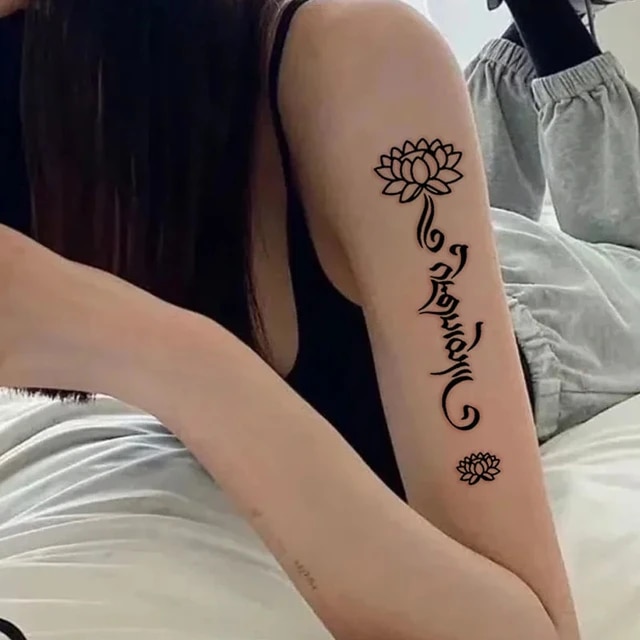
In ancient Egypt, the lotus flower was also associated with the god Osiris, who was the god of resurrection and rebirth. Osiris was often depicted holding a lotus scepter, which represented his power over life and death. The lotus flower thus became a symbol of hope and new beginnings, as well as a reminder of the cycle of life and death.
In addition to its association with rebirth and creation, the lotus flower also represented purity and enlightenment. This is because of its unique ability to grow in muddy waters and emerge unblemished and beautiful. This characteristic made it a potent symbol of spiritual growth and transcendence, as it represented the idea that one could rise above the mire of worldly concerns and attain enlightenment.
Hieroglyphs Tattoo
Egyptian tattoos that feature hieroglyphs are a popular choice for people who want to express their appreciation for ancient Egyptian culture, or for those seeking to convey a specific message or symbol through body art. Hieroglyphs were used by the ancient Egyptians as a form of written language, and each character held its own unique meaning.
Many people choose to get tattoos of specific hieroglyphs because they hold personal significance to them. For example, someone might choose the hieroglyph for “strength” or “courage” if they feel that those qualities are important in their life. Others might choose a hieroglyph that represents a loved one’s name or a word that holds special meaning to them.

One popular hieroglyph that is often used in tattoos is the Ankh, which represents eternal life. The Ankh was a powerful symbol in ancient Egypt, and many people still believe in its ability to bring spiritual well-being and protection. Another popular hieroglyph is the Eye of Horus, which is associated with healing and protection.
It is important to note that while hieroglyphic tattoos can be beautiful and meaningful, it is essential to ensure that the symbols are being used correctly and respectfully. People should properly research the meanings behind the hieroglyphs they are considering getting tattooed and seek out a reputable artist who is experienced in creating Egyptian-inspired designs.
Wadjet Tattoo
Egyptian tattoos have a rich history and are often imbued with deep symbolism that reflects the ancient Egyptian culture’s beliefs, traditions, and deities. One of the most powerful and revered figures in Egyptian mythology is the goddess Wadjet. She is commonly depicted as a cobra, which was considered a sacred animal in ancient Egypt.
Wadjet represented protection, royalty, and divine power in Egyptian mythology. As a symbol of protection, she was believed to offer safeguarding and ward off evil spirits. In her role as a symbol of royalty, Wadjet was associated with the pharaohs and was believed to protect their power and authority. She was also seen as a powerful deity who embodied divine power and strength.
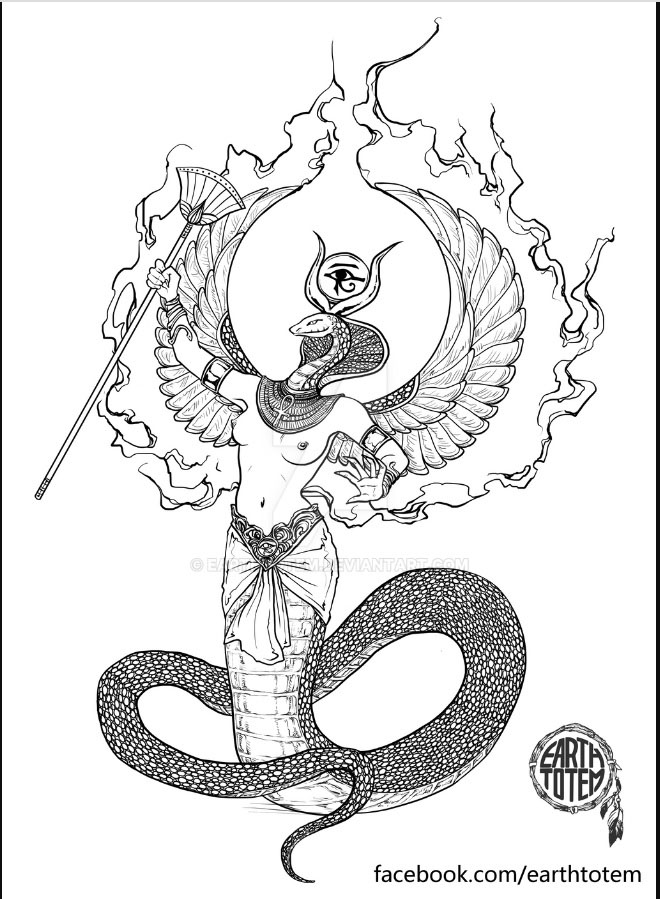
A tattoo of Wadjet can thus represent a number of different meanings based on her various associations. For instance, a tattoo of Wadjet can be seen as an expression of strength and authority, as she was a symbol of power in ancient Egypt. It can also represent protection and guidance, both in terms of physical safety and spiritual wellbeing. Additionally, a tattoo of Wadjet can suggest a connection to ancient Egyptian culture and mythology, reflecting a deep appreciation for its rich history and traditions.
Pharaoh Tattoo
Egyptian tattoos are a popular choice for people interested in history, culture, and symbolism. These tattoos often incorporate images and designs from the ancient Egyptian civilization, which has long been admired for its impressive architecture, art, and mythology. One common image that appears in many Egyptian tattoos is that of the pharaoh.
Pharaohs were the rulers of ancient Egypt, and they held significant power and authority in their society. Depicting a pharaoh in a tattoo can therefore symbolize leadership and authority, as well as the pursuit of greatness and success. The pharaoh was seen as a divine figure and was often associated with the gods, so having a pharaoh tattoo can also represent a connection to the divine or higher powers.
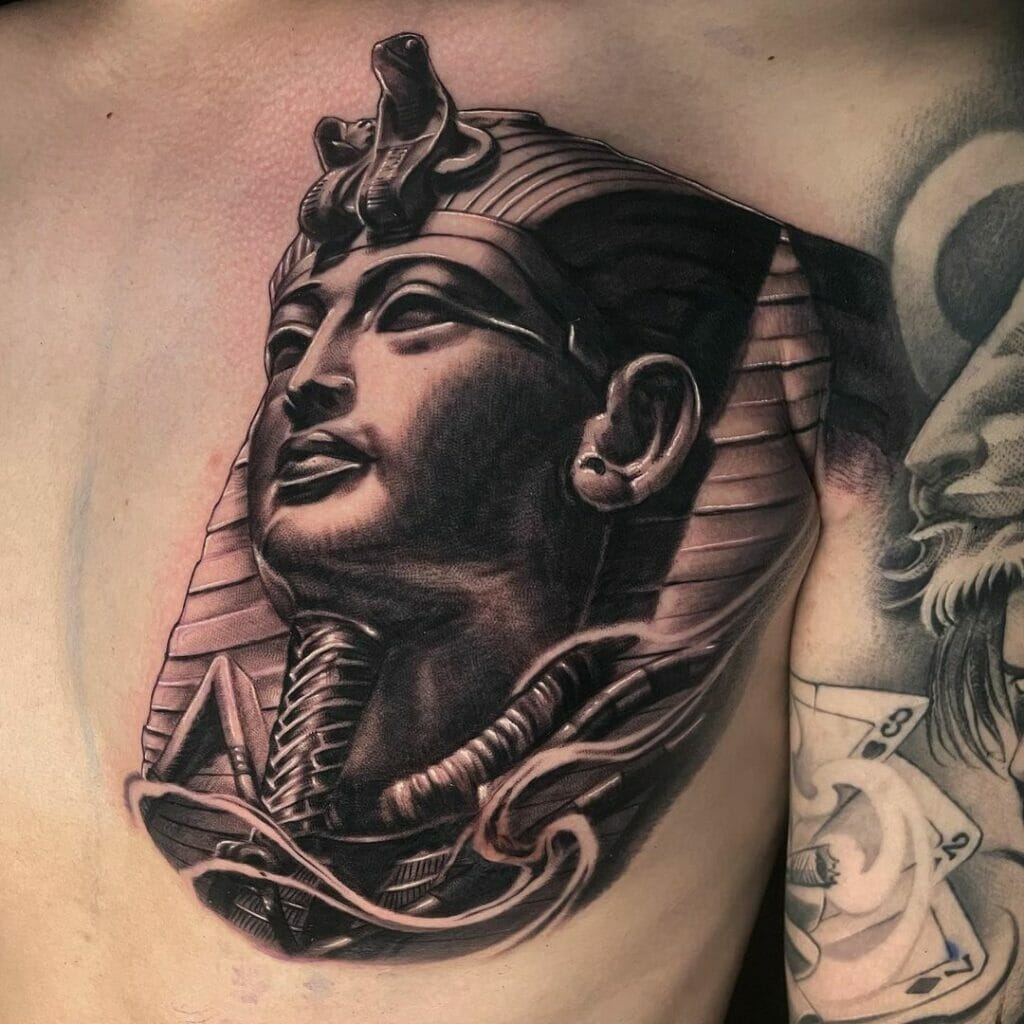
In addition to these more general meanings, there may be specific connotations associated with different pharaohs. For example, Tutankhamun is one of the most famous pharaohs, and his image might be used to represent rebirth and renewal. Cleopatra, who was actually a queen rather than a pharaoh, is another popular figure for tattoos, and she is often associated with beauty, grace, and power.
Egyptian tattoos may also incorporate other elements from ancient Egyptian culture, such as hieroglyphics or gods and goddesses like Anubis or Isis. These symbols can add additional layers of meaning to the tattoo, depending on the specific design and context.
When getting an Egyptian tattoo, it’s important to research the symbols and their meanings thoroughly to ensure that they align with your understanding and intentions. Additionally, consider how the imagery connects with your personal beliefs and values to make the tattoo meaningful to you.
Different Types of Egyptian Tattoo Designs
Egyptian tattoos come in a wide variety of styles and designs. Some people prefer traditional or classic designs, while others opt for more modern interpretations. Here are some of the most popular types of Egyptian tattoo designs.
Classic Designs
Classic Egyptian tattoo designs include hieroglyphics, ankh symbols, scarab beetles, and other symbols that have been used for centuries. These designs are often rendered in black ink and can be highly detailed and intricate.
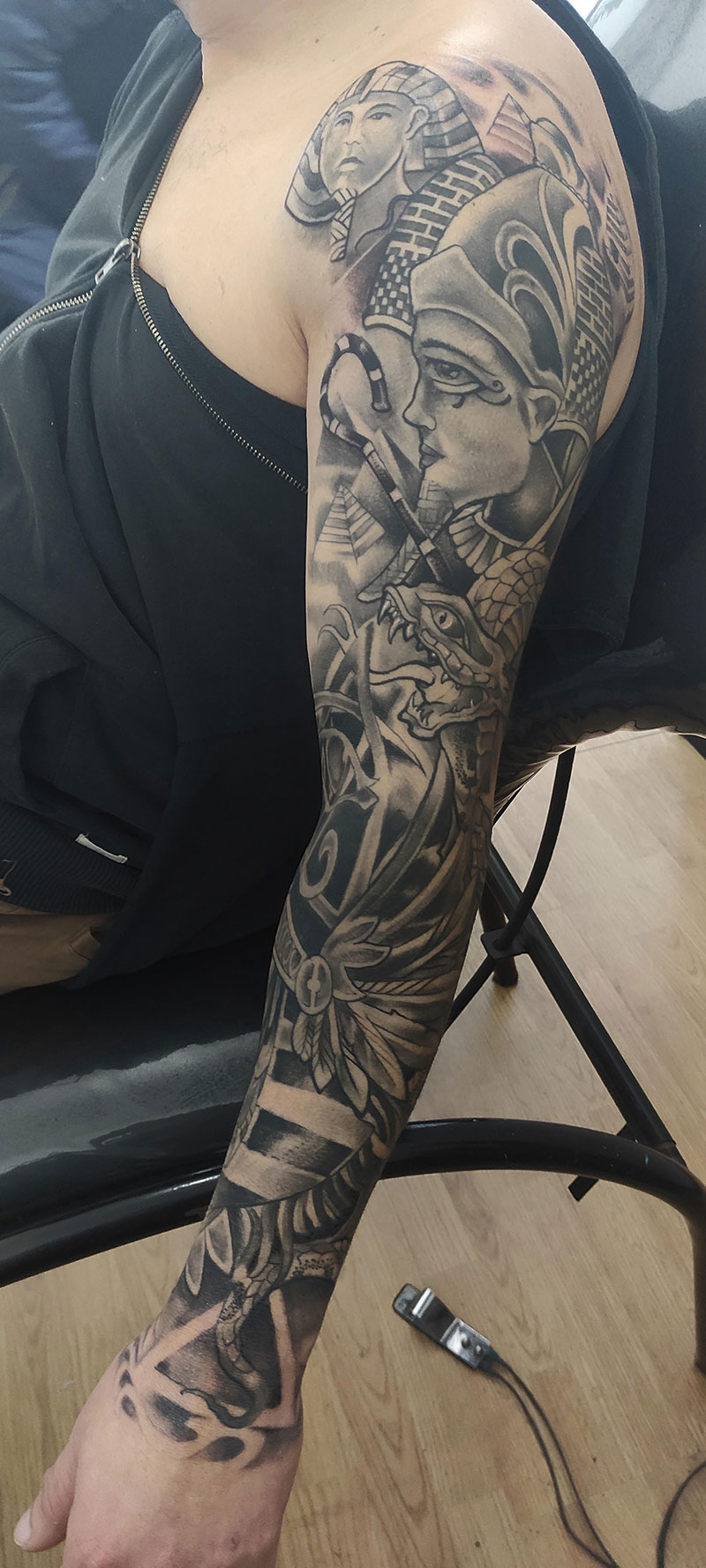
Realistic Portraits
Some people opt for realistic portraits of pharaohs, queens, or other important figures from ancient Egypt. These tattoos can be incredibly detailed and may require multiple sessions to complete.
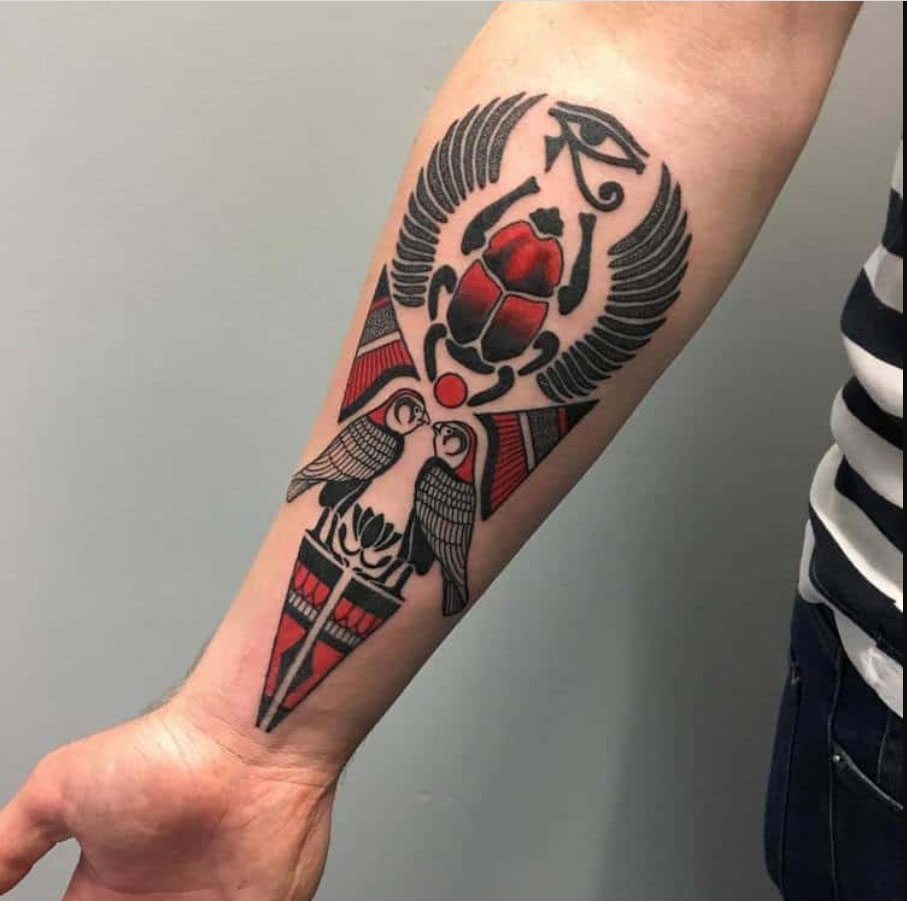
Modern Interpretations
Many people choose to interpret Egyptian symbols and designs in a more modern way. These designs may incorporate elements of contemporary art or graphic design, giving them a unique and edgy feel.
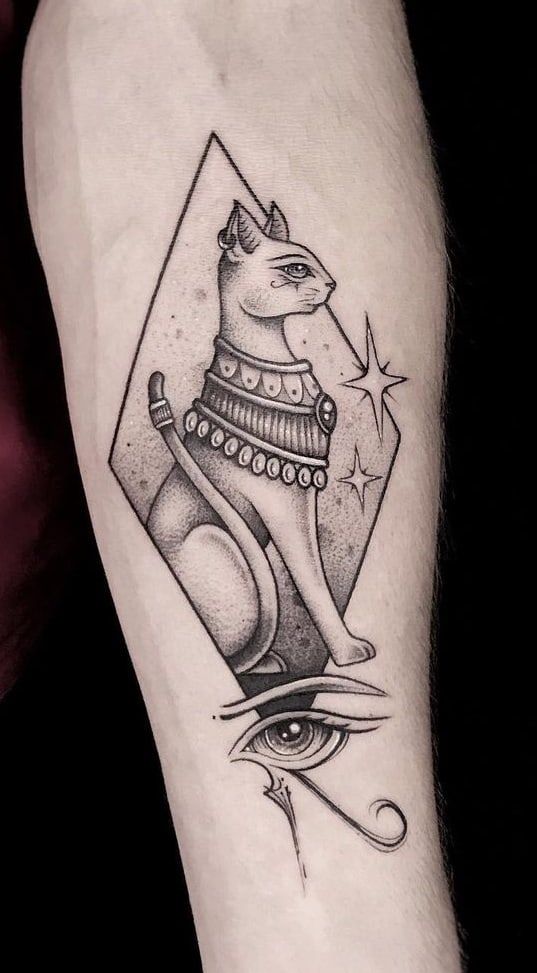
Colorful Designs
While classic Egyptian tattoo designs are often rendered in black ink, many people opt for colorful designs that incorporate a range of hues. These tattoos can be incredibly eye-catching and visually stunning.
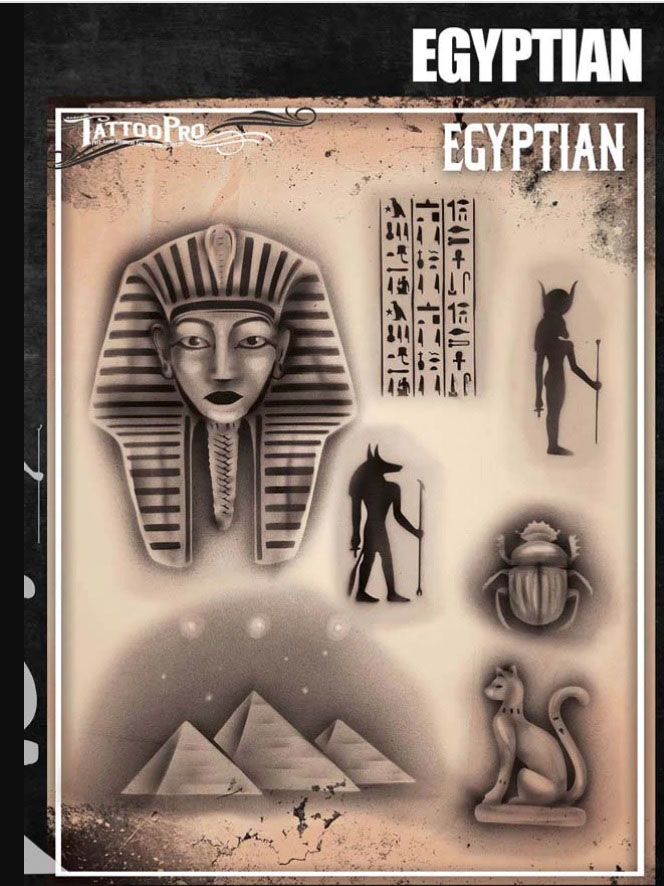
Conclusion: Egyptian Tattoo Meaning
Egyptian tattoos are rich in history and symbolism, making them an excellent choice for anyone looking for a meaningful and visually stunning tattoo design. Whether you’re drawn to classic designs or more modern interpretations, there’s an Egyptian tattoo out there for everyone. By choosing a design that speaks to you on a personal level and working with a skilled tattoo artist, you can create a timeless piece of body art that you’ll love for years to come.

I am Harvey Berry, a tattoo enthusiast who has immersed himself in the diverse world of ink, passionately exploring the beauty and artistry within each tattoo. My mission extends beyond uncovering the aesthetics of tattooing; it involves sharing in-depth knowledge across all aspects of this art form.
Fueled by genuine curiosity and love for every facet of tattooing, I have diligently crafted well-researched articles, with a special focus on the Tattoo Meaning of Impeccable Nest section. Here, my aim is to help the tattoo community gain a deeper understanding of the meanings and values embedded in each tattoo.
One of my primary goals is to encourage responsible decision-making when it comes to getting inked. I recognize that choosing to get a tattoo is a significant personal decision that requires careful consideration. Hence, I provide diverse resources covering the meaning of tattoos, the tattooing process, aftercare tips, and other valuable information.
Whether you are a seasoned tattoo enthusiast or embarking on your first exploration of the world of body art, I aspire to be a reliable resource for you at every step of your journey. I hope that my extensive knowledge of tattoos, especially in the Tattoo Meaning section, will assist you in finding inspiration to express yourself through the art of tattoos.
